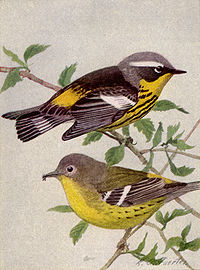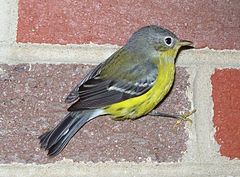- Magnolia Warbler
-
Magnolia Warbler 
Adult and Immature Male. Conservation status Scientific classification Kingdom: Animalia Phylum: Chordata Class: Aves Order: Passeriformes Family: Parulidae Genus: Setophaga Species: S. magnolia Binomial name Setophaga magnolia
(Wilson, 1811)Synonyms Dendroica maculosa
Setophaga magnolia, commonly known as the Magnolia warbler, is a member of the Parulidae family of wood warblers. [4] This warbler was first discovered in magnolia trees in the 19th century by famed ornithologist Alexander Wilson while in Mississippi. [7]
Contents
Description
The magnolia warbler can be distinguished by its coloration. The breeding males often have white, gray, and black backs with yellow on the sides; yellow and black-speckled stomachs; white, gray, and black foreheads and beaks; distinct black tails with white stripes on the underside; and defined white patches on their wings, called wing bars. [3] Breeding females usually have the same type of coloration as the males, except that their colors are much duller. Immature warblers also resemble the same dull coloration of the females. [7] The warbler regularly measures a little less than 15 centimeters. For the males, their yellow and black-speckled stomachs help one to tell them apart from other similar birds when in pictures, like the Prairie warbler and Kirtland’s warbler. However, in their breeding habitat, it is easy to know a magnolia warbler from other similar-looking birds because others such as the prairie warbler and Kirtland’s warbler are only found in eastern North America or Michigan and southern Ontario, respectively, in comparison with its northern Canadian habitat. [3]
Distribution and Migration
S. magnolia is found in the northern parts of some Midwestern states and the very northeastern parts of the US, with states such as Minnesota and Wisconsin comprising its southernmost boundaries. However, it is mostly found across the northern parts of Canada, such as in Saskatchewan, Manitoba, Ontario, and Quebec. During the winter, the warbler migrates through the eastern half of the United States to southern Mexico and Central America. [1] As it passes through the eastern part of the United States, it occupies states as far west as Oklahoma and Kansas. The Magnolia warbler does not breed in the winter, but rather just migrates to the warmer south – southeastern Mexico, Panama, and parts of the Caribbean. [2]
Habitat
The warbler often lives in the dense forests of northeastern North America, such as in northern Canada. [7] If in its area of distribution, the Magnolia warbler will most likely be found among the branches of young, densely-packed, coniferous trees. [3] During migration season, the magnolia warbler can also be found living in woodlands.
Life Cycle
The Magnolia warbler undergoes multiple molts during its lifetime. The first molts begin while the young offspring are still living in the nest, while the rest take place on or near their breeding grounds. [3] The warblers molt, breed, care for their offspring, and then migrate. Chicks hatch after a two-week incubation period, and can fledge from the nest after close to another two weeks when their feathers are more developed. After about a month, the chicks can leave the nest to begin living (and later breeding) on their own since they are solitary birds. Magnolia warblers typically live up to 7 years. [11]
Diet & Feeding Behavior
This warbler usually eats any type of arthropod, but their main delicacies are caterpillars. [9] The warbler also feeds on different types of beetles, butterflies, spiders, and fruit during their breeding season, while they increase their intake of both fruit and nectar during the winter.[3] These birds also tend to eat parts of the branches of mid-height coniferous trees, such as spruce firs [9], in their usual breeding habitat.
Behavior
Songs
Researchers have observed two different types of song calls in male magnolia warblers. Their songs have been referred to as the First Category song and the Second Category song. [5] Females have not been observed to have a distinct song yet as the males have; while they do sing, they don’t have separate songs for different situations. In general, the male warblers use their songs during the spring migration season and during the breeding season: one is used for courtship and the other is used to mark their territory each day. [5] Both males and females have call notes that they use for various alerts: the females have short call notes to signal when a human observer is watching them, and the males have short call notes to signal when any sort of threatening predators are close to their offspring.
Conservation
According to the IUCN Red List, the Magnolia warbler is on the list of “Least Concern” for conservation organizations because it is fairly widespread and common within its habitat and not at risk of extinction. Research has shown that a good percentage of warblers die from flying into television towers in their migratory path. Also, parts of their habitat have been denigrated as coniferous forests are cleared which causes the number of warblers living in a habitat to decrease, but they certainly are not greatly affected by the deforestation. While the deforestation does decrease the warbler population in the specific area that it occurs in, the species is not significantly impacted overall due to the general abundance of the species throughout the region. [10]
Mating and Breeding
Male Magnolia warblers go to their breeding grounds about two weeks before the females arrive. After the females come to the breeding grounds, both the males and females cooperate to build the nest for a week. Because of the difficulty of locating their nests among the forest’s dense undergrowth, it is hard to know whether the warblers re-use their original nests each breeding season, or whether they abandon them for new ones. The nests are built in their tree of choice – different types of fir trees [7], such as Abies balsamea (balsam fir) and Picea glauca (spruce fir). The nest is made up of grass, twigs, and horsehair fungus, and they are relatively small, shallow, circular-shaped nests, barely exceeding 10 centimeters on all sides. [3] The nests are usually found close to the ground, commonly in the lowest three meters of the firs.
Parental Care
Female magnolia warblers usually lay three to five eggs during each breeding season. The female will not incubate her eggs until all of them are laid. The female sits on the eggs for about two weeks before the eggs hatch. The female is also the one that warms the newborn chicks by brooding, or sitting, on the nest; she is also the one who feeds the newborn chicks most frequently, though the males also engage in feeding the offspring at times. [8] Because the males are technically as equally responsible for feeding the newborns as the females are, this means that the males are monogamous because they expend a large amount of energy looking for food for their young. In order to keep the nest clean, females eat the fecal sacs of their newborns; as the chicks grow older, both parents simply remove the sacs from the nest. The baby warblers are ready to fly out of the nest by the time they are ten days old.
In art
John James Audubon illustrates the Magnolia Warbler in Birds of America, Second Edition (published, London 1827–38) as Plate 123 under the title, "Black & Yellow Warbler – Sylvia maculosa" where a pair of birds (male and female) are shown searching flowering raspberry for insects. The image was engraved and colored by Robert Havell's, London workshops. The original watercolor by Audubon was purchased by the New York History Society where it remains to this day (January 2009).
References
- BirdLife International (2004). Dendroica magnolia. 2006. IUCN Red List of Threatened Species. IUCN 2006. www.iucnredlist.org. Retrieved on 12 May 2006. Database entry includes justification for why this species is of least concern
New World Warblers by Curson, Quinn and Beadle, ISBN 0-7136-3932-6
1. Hitch, A. T. and Leberg, P. L. 2007. Breeding Distributions of North American Bird Species Moving North as a Result of Climate Change. Conservation Biology 21: 534–539. DOI: 10.1111/j.1523-1739.2006.00609.x
2. Boone, A. T., Rodewald, P. G., and Degroote, L. W. 2010. Neotropical Winter Habitat of the Magnolia Warbler: Effects on Molt, Energetic Condition, Migration Timing, and Hematozoan Infection During Spring Migration. The Condor 112: 115–122. doi: 10.1525/cond.2010.090098
3. Dunn, E. and Hall, G. A. 2010. Magnolia Warbler (Dendroica magnolia), The Birds of North America Online (A. Poole, Ed.). Ithaca: Cornell Lab of Ornithology; Retrieved from the Birds of North America Online. doi:10.2173/bna.136
4. Billetdeaux, S. and Verser, D. Magnolia Warbler (Dendroica magnolia). Houston Audubon Society Species Accounts Online.
5. Morse, D. H. 1989. Song Patterns of Warblers at Dawn and Dusk. The Wilson Bulletin (Published by Wilson Ornithological Society) 101: 26–35.
6. Nice, M. M. 1926. A Study of a Nesting of Magnolia Warblers (Dendroica magnolia). The Wilson Bulletin (Published by Wilson Ornithological Society) 38(4): 185–199.
7. 2009. Magnolia Warbler (Dendroica magnolia). Audubon Guides (Allied with National Audubon Society).
8. Allen, J. and Islam, K. 2004. Gender Differences in Parental Feeding Effort of Cerulean Warblers at Big Oaks National Wildlife Refuge, Indiana. Indiana Academy of Science 113(2): 162–16 5.
9. Morse, D. H. 1976. Variables Affecting the Density and Territory Size of Breeding Spruce-Woods Warblers. Ecology 57: 290–301.
10. Germaine, S. S., Vessey, S. H. and Capen, D. E. 1997. Effects of Small Forest Openings on the Breeding Bird Community in a Vermont Hardwood Forest. The Condor 99: 708–718.
11. National Geographic Society. 2002. National Geographic field guide to the birds of North America, Fourth Edition. National Geographic Society, Washington, DC.
External links
- John James Audubon's Birds of America – Close-ups of Plate 123
- Magnolia Warbler – Dendroica magnolia – USGS Patuxent Bird Identification InfoCenter
- Magnolia Warbler Species Account – Cornell Lab of Ornithology
- Magnolia Warbler Information and Photos – South Dakota Birds and Birding
Categories:- IUCN Red List least concern species
- Birds of Canada
- Dendroica
Wikimedia Foundation. 2010.


